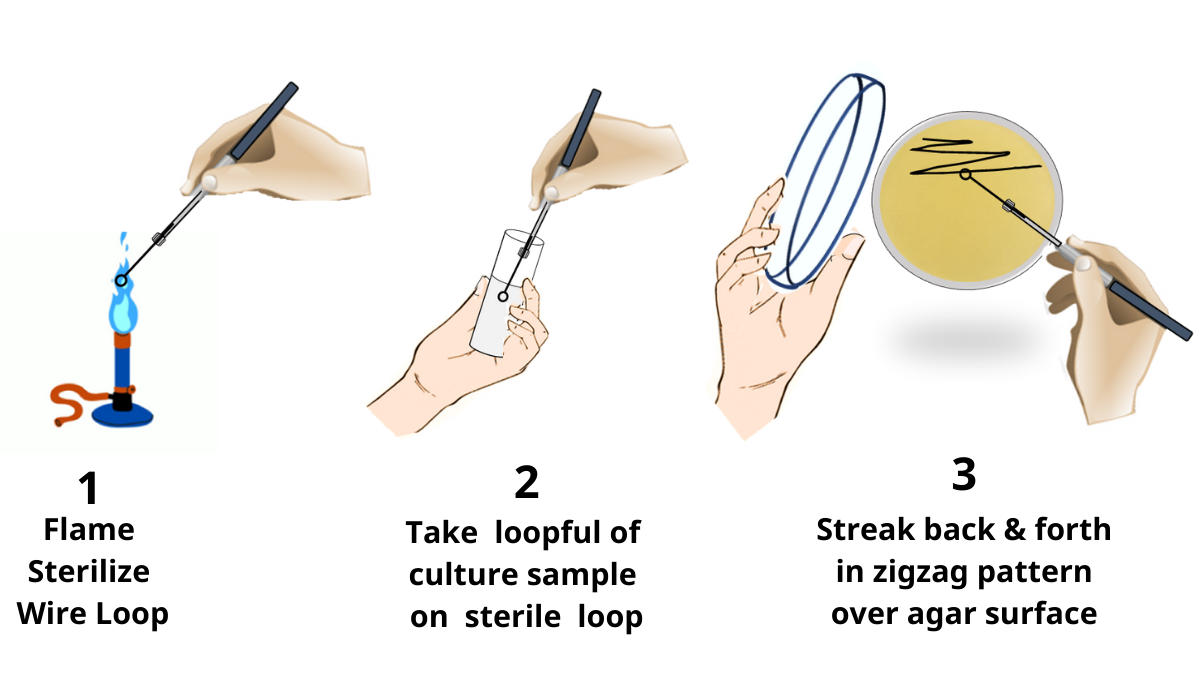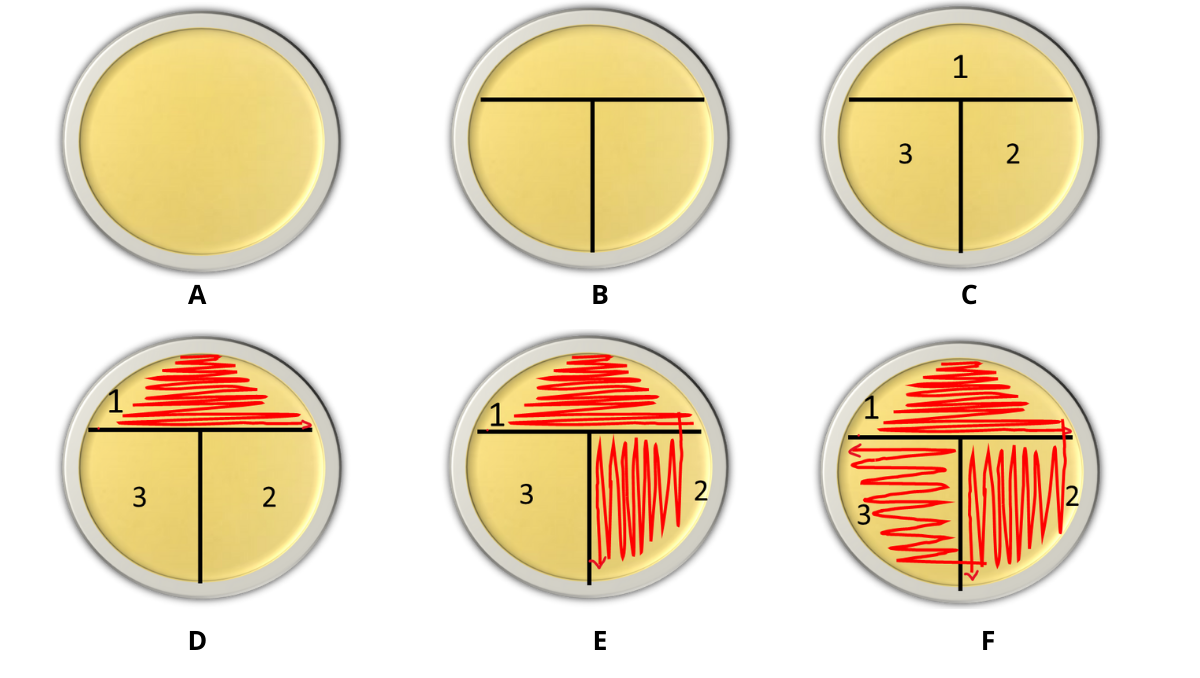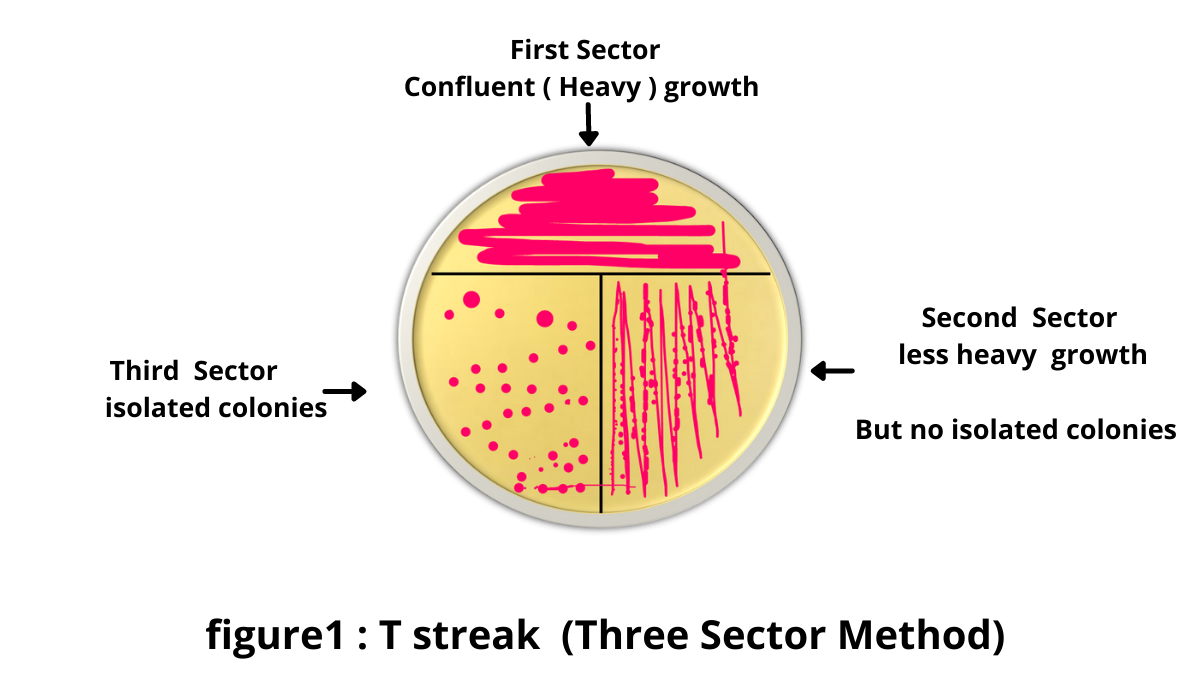Our life is full of microorganisms. We daily come into contact with thousands of microbes. The water, air, food, soil all contain a wide variety of microbial populations. A microbial population having two or more species of microorganism is a mixed microbial population. Individual species of microorganisms are isolated from the mixture of the microbial population using many methods. Two popular methods for isolation are the Streak plate and the pour plate method. Here we are going to discuss the streak plate method.
Streak Plate Method Principal:
The streak plate method is an isolation procedure used to isolate bacteria from a mixed bacterial culture. It is a dilution technique in which a bacterial sample is streaked over the agar surface in quadrants so that bacterial cell density gets diluted and individual cells spread over the agar surface. These individual bacterial cells grow and form isolated colonies. An isolated colony is further transferred in a separate sterile medium and pure culture is obtained.
First, let us understand the microbial culture. Microbial cultures are of two types 1. Mixed Culture 2. Pure Culture
1. Mixed Culture: two or more species of microorganism or bacteria are present in mixed culture.
2. Pure culture: single species of microorganism or bacteria is present in Pure culture.In nature, bacteria exist in mixed populations. Our aim is to isolate pure culture containing single bacteria from mixed culture of many bacteria. The streak plate method is widely used to isolate pure culture.
Materials Required:
The following apparatus is required for the streak plate technique.
1. Bunsen Burner
2. Nichrome Wire Loop
3. Sterile Nutrient Agar plates
4. Mixed Culture of bacteria.
Steps in streak Plate Method:

Watch video given below on how to perform different steps of streak plate method.
Bacterial culture sample is streaked over agar surface in several patterns. Some patterns are simple whereas some are complex. The Agar surface in a petri dish is streaked in various sections. Depending upon the number of agar sections streaked, the following are patterns of streaking.
1. T Streak
2. Quadrant streak
3. Zigzag Streak
4. Radiant Streak
5. Continuous streak
T streak:
This is a three-sector streak method. In this streaking pattern, three sections of agar plates are streaked. The agar plate is divided into three sections. This method can be done using a sterile wire loop. A loopful of a liquid sample containing a mixture of bacteria is taken using a sterile wire loop and then is spread over the agar surface in Petri pate in three sections in a sequential manner. That’s why it is called Three sector method. Initially, there is heavy confluent growth in the initial section. A number of cells get fewer in the second section. In the final section, growth is very less and we get isolated colonies.
T Streak Steps:
1. Take a sterile nutrient agar plate.
2. Draw a letter T on the bottom side of an agar plate
3. Number three sections of the plate as 1,2,3
4. Flame sterilize wire loop, allow it to cool completely, take loopful of sample and place in area 1 and streak back and forth in a zigzag motion to spread culture.
5. Now again wire loop is flame sterilized and now the Petri plate is rotated at 90 degrees. Now drag wire loop from the corner of area 1 just touching a few previously streaked lines into area 2 and a zigzag pattern streak is done in area 2 (see fig E).
6. Again, the wire loop is sterilized on flame. Now drag wire loop from the corner of area 2 just touching a few previously streaked lines into area 3 and a zigzag pattern streak is done in area 3. (see fig F)

After plating the agar Petri plate is kept in an incubator at 36 o C.
A good T streak of bacterial isolation will look like below.

Watch video given below on how to perform T streak method
Four Quadrant Streak :
This is the most popular and most preferred procedure to get isolated colonies of the bacteria. Quadrant streak is also known as the four sectors method or four-quadrant streak because four equal-sized sections in Agar plates are streaked. When a sample contains a high density of bacterial cells then the four-quadrant method is used to get isolated colonies of bacteria. A sample containing a high number of bacterial cells is streaked with the sterile wire loop. The wire loop is streaked over the agar surface in a way that most of the area in the agar plate gets deposited by a single cell.
Steps of Four-way Streak or quadrant streak:
1. Sterilize the wire loop on flame and allow it to cool for a few seconds. Dip the loop in the Liquid sample containing a mixture of bacteria. A Loopful of culture sample is streaked on the agar surface in area 1
2. Now again wire loop is flame sterilized and now the Petri plate is rotated at 90 degrees. A wire loop is placed in corner of area 1 and dragged several times through area 2 and a zigzag pattern streak is done in area 2. This step brings a few bacteria from area 1 into area two
3. Again, the wire loop is sterilized on flame. Now drag wire loop several times from the corner of area 2 touching previously streaked lines into area 3 and a zigzag pattern streak is done in area 3.
4. In the same way using a sterile loop the culture from area 3 is streaked into area 4. In Area, 4 wider streaks go towards the middle of the agar plate. In this area bacterial cell number is very less so isolated colonies are formed here.

Watch video given below on how to perform four quadrant streak method.
Zigzag Streak:
zigzag streak pattern used to inoculate samples containing low bacterial cell density. If you want to inoculate pure culture and isolation is not necessary then a zigzag pattern is performed. For this procedure, a sterile cotton swab also can be used.
Zigzag Streak steps:
1. Sterilize the wire loop on flame and allow it to cool for a few seconds. Or use a sterile cotton swab
2. Dip the loop or cotton swab in the liquid sample containing a mixture of bacteria. A Loopful of culture sample is taken on a wire loop
3. Open the lid of the agar plate for inoculation.
4. Drag the loop or swab over the agar surface in a zigzag pattern. Use the entire area of the plate for the inoculation.
5. Replace the lid immediately and hold the loop in flame to sterilize. Dispose of the cotton swab
6. Invert the plate, label it, and keep the plate in an inverted position for incubation.
7. Watch video given below on how to perform Zigzag Streak Pattern.
Radiant streak:
In this streak pattern, a loopful culture sample is spread near the edge of the agar plate in area 1. The sample is streaked in a radial direction from this edge dragging straight lines towards the opposite side from the area1. About 7 or 8 straight streaks are generally performed. Then a flame sterile loop is used to streak horizontal lines near above area 1.
Continuous streak:
Take a loopful of culture sample and starting from area A spread it in a single continuous movement to the centre of the plate. When the streak reaches the center then rotate the plate 180 degrees. Use the same loop to streak area B. Without flaming the loop streak the remaining portion of agar surface in area B.

Advantages of Streak Plate Method :
1. Streak plate techniques are the most popular and widely used procedure of isolating specific bacteria from a mixed population of bacteria.
2. Streak can be performed in many patterns.
3. It is the first step in the identification study of any microorganism.
4. Streak plate method is a less time-consuming method
5. Heat sensitive organisms are not affected
6. Aerobic microbes grow easily.
Limitations of Streak Plate Method:
1. There are high chances of contamination while streaking
2. This method is not suitable for the growth of anaerobes.
3. This is qualitative method and not suitable for microbial enumeration.
Am really grateful for impacting more knowledge and improve our skills on microbiology